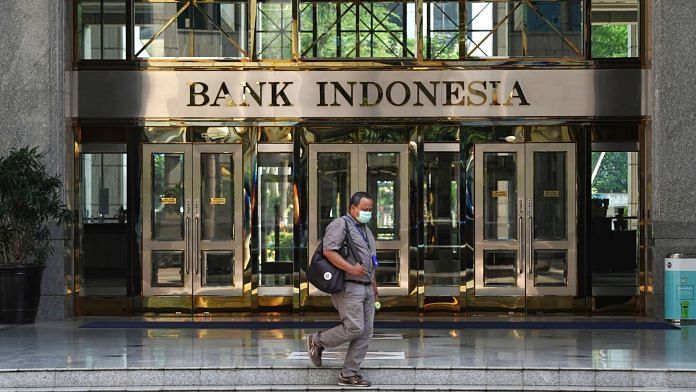Some of the most radical practitioners of monetary easing are falling into line. The first two years of the pandemic were defined by ultra-low interest rates and a rare degree of experimentation to boost growth and steady markets. This wasn’t just a feature of advanced economies: Emerging markets also jumped into the fray. Few were as bold as Indonesia, though, which used the central bank to directly finance an expansion in government spending. That it’s turning hawkish is a stark reminder of how times have changed.
Bank Indonesia Governor Perry Warjiyo now finds himself in the business of forecasting Federal Reserve rate hikes. He predicts four increases, beginning as soon as March, a pace and timing that Fed Chair Jerome Powell has yet to endorse. What transpires in Washington has important consequences for Indonesia, which is prioritizing the stability of its currency and financial markets.
Like most central banks, BI says it doesn’t have to move in lockstep with the Fed. Historically, however, many tend to follow America’s lead. The nuance is often in pace and degree. At a briefing Thursday, Warjiyo left little doubt that rates are headed higher, sooner rather than later. Jakarta could lift its benchmark rate from a record low within hours of the conclusion of the Federal Open Market Committee’s March 15-16 meeting, Wellian Wiranto, an economist at Oversea-Chinese Banking Corp., wrote in a note.
Warjiyo surprised markets last week by raising the level of reserves lenders are required to hold starting in March. He even embraced the term “normalization,” code for withdrawing largesse. If this all sounds thoroughly conventional, it is — except that the country is merging into the mainstream from the far lane. It’s almost as though Indonesia’s testing of the outer limits of monetary conventions never happened.
There was always going to be a time normal service would resume. Bank Indonesia needed — and mostly enjoyed — a benign global policy landscape to undertake the purchase of bonds directly from the government in 2020, initially billed as a one-off and then extended for two years. Prior to the pandemic, overt debt monetization was a no-no and contrary to the orthodox lines along which BI was reorganized after the Asian financial crisis of the late 1990s. It would be difficult to reconcile Warjiyo’s new language with further monetary adventures.
Indonesia became an avatar of what was possible in extraordinary times. Across the Americas, Europe and Asia, rates went to nearly zero, led by the Fed. Versions of quantitative easing were launched in countries that recoiled from going that far after the collapse of Lehman Brothers Holdings Inc. While very low inflation once underpinned such accommodation, that narrative is now fading.
Policy makers will pivot at their own speed, shaped by local conditions. Some veterans of the ultra-easy era stress their autonomy. Bank of Japan Governor Haruhiko Kuroda says it’s “unthinkable” for rates to climb. “We are all in different situations,” European Central Bank President Christine Lagarde told France Inter radio Thursday.
Japan and the euro zone are worlds away from Indonesia. They aren’t emerging markets. The euro is a reserve currency, albeit nowhere near as critical as the dollar. And Japan pioneered QE. For both, cheap money is the status quo, not the exception. They are less at the mercy of global capital flows than developing countries.
Indonesia didn’t exactly become a trendsetter in its monetization. The Philippines, for one, dabbled in a soft version of it, but the practice never caught on big time. Rates are now heading up, perhaps steeply and soon. Never mind the FOMC’s famous dot plot. You heard it in Jakarta.- Bloomberg
Also read: High fuel costs unsettle governments in India, other Asian nations as inflation poses challenge



